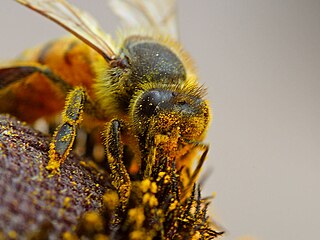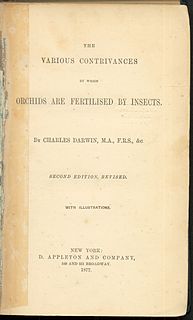
Orchids are plants that belong to the family Orchidaceae, a diverse and widespread group of flowering plants with blooms that are often colourful and fragrant.

Reproduction is the biological process by which new individual organisms – "offspring" – are produced from their "parent" or parents. Reproduction is a fundamental feature of all known life; each individual organism exists as the result of reproduction. There are two forms of reproduction: asexual and sexual.

A pollinator is an animal that moves pollen from the male anther of a flower to the female stigma of a flower. This helps to bring about fertilization of the ovules in the flower by the male gametes from the pollen grains.

Pollination is the transfer of pollen from an anther of a plant to the stigma of a plant, later enabling fertilisation and the production of seeds, most often by an animal or by wind. Pollinating agents can be animals such as insects, birds, and bats; water; wind; and even plants themselves, when self-pollination occurs within a closed flower. Pollination often occurs within a species. When pollination occurs between species, it can produce hybrid offspring in nature and in plant breeding work.

Pollination of fruit trees is required to produce seeds with surrounding fruit. It is the process of moving pollen from the anther to the stigma, either in the same flower or in another flower. Some tree species, including many fruit trees, do not produce fruit from self-pollination, so pollinizer trees are planted in orchards.

Self-pollination is a form of pollination in which pollen from the same plant arrives at the stigma of a flower or at the ovule. There are two types of self-pollination: in autogamy, pollen is transferred to the stigma of the same flower; in geitonogamy, pollen is transferred from the anther of one flower to the stigma of another flower on the same flowering plant, or from microsporangium to ovule within a single (monoecious) gymnosperm. Some plants have mechanisms that ensure autogamy, such as flowers that do not open (cleistogamy), or stamens that move to come into contact with the stigma. The term selfing that is often used as a synonym, is not limited to self-pollination, but also applies to other types of self-fertilization.

Phalaenopsis, also known as moth orchids, is a genus of about seventy species of plants in the family Orchidaceae. Orchids in this genus are monopodial epiphytes or lithophytes with long, coarse roots, short, leafy stems and long-lasting, flat flowers arranged in a flowering stem that often branches near the end. Orchids in this genus are native to India, Taiwan, China, Southeast Asia, New Guinea and Australia with the majority in Indonesia and the Philippines.
Self-incompatibility (SI) is a general name for several genetic mechanisms that prevent self-fertilization in sexually reproducing organisms, and thus encourage outcrossing and allogamy. It is contrasted with separation of sexes among individuals (dioecy), and their various modes of spatial (herkogamy) and temporal (dichogamy) separation.

Buzz pollination or sonication is a technique used by some bees, such as solitary bees to release pollen which is more or less firmly held by the anthers. The anthers of buzz-pollinated plant species are typically tubular, with an opening at only one end, and the pollen inside is smooth-grained and firmly attached. With self-fertile plants such as tomatoes, wind may be sufficient to shake loose the pollen through pores in the anther and accomplish pollination. Visits by bees may also shake loose some pollen, but more efficient pollination of those plants is accomplished by a few insect species who specialize in sonication or buzz pollination.

Sequential hermaphroditism is a type of hermaphroditism that occurs in many fish, gastropods, and plants. Sequential hermaphroditism occurs when the individual changes its sex at some point in its life. In particular, a sequential hermaphrodite produces eggs and sperm at different stages in life. Species that can undergo these changes from one sex to another do so as a normal event within their reproductive cycle that is usually cued by either social structure or the achievement of a certain age or size.

Entomophily or insect pollination is a form of pollination whereby pollen of plants, especially but not only of flowering plants, is distributed by insects. Flowers pollinated by insects typically advertise themselves with bright colours, sometimes with conspicuous patterns leading to rewards of pollen and nectar; they may also have an attractive scent which in some cases mimics insect pheromones. Insect pollinators such as bees have adaptations for their role, such as lapping or sucking mouthparts to take in nectar, and in some species also pollen baskets on their hind legs. This required the coevolution of insects and flowering plants in the development of pollination behaviour by the insects and pollination mechanisms by the flowers, benefiting both groups.

Zoophily, or zoogamy, is a form of pollination whereby pollen is transferred by animals, usually by invertebrates but in some cases vertebrates, particularly birds and bats, but also by other animals. Zoophilous species frequently have evolved mechanisms to make themselves more appealing to the particular type of pollinator, e.g. brightly colored or scented flowers, nectar, and appealing shapes and patterns. These plant-animal relationships are often mutually beneficial because of the food source provided in exchange for pollination.
Plant breeders use different methods depending on the mode of reproduction of crops, which include:

Coryanthes, commonly known as bucket orchids, is a genus of tropical epiphytic orchids. This genus is abbreviated as Crths in horticultural trade. They are native to South America, Central America, Mexico and Trinidad.

A flower, sometimes known as a bloom or blossom, is the reproductive structure found in flowering plants. The biological function of a flower is to facilitate reproduction, usually by providing a mechanism for the union of sperm with eggs. Flowers may facilitate outcrossing resulting from cross-pollination or allow selfing when self-pollination occurs.
Plant reproduction is the production of new offspring in plants, which can be accomplished by sexual or asexual reproduction. Sexual reproduction produces offspring by the fusion of gametes, resulting in offspring genetically different from either parent. Asexual reproduction produces new individuals without the fusion of gametes, resulting in clonal plants that are genetically identical to the parent plant and each other, unless mutations occur.

Fertilisation of Orchids is a book by English naturalist Charles Darwin published on 15 May 1862 under the full explanatory title On the Various Contrivances by Which British and Foreign Orchids Are Fertilised by Insects, and On the Good Effects of Intercrossing. Darwin's previous book, On the Origin of Species, had briefly mentioned evolutionary interactions between insects and the plants they fertilised, and this new idea was explored in detail. Field studies and practical scientific investigations that were initially a recreation for Darwin—a relief from the drudgery of writing—developed into enjoyable and challenging experiments. Aided in his work by his family, friends, and a wide circle of correspondents across Britain and worldwide, Darwin tapped into the contemporary vogue for growing exotic orchids.

The monocots are one of the two major groups of flowering plants, the other being the dicots. In order to reproduce they utilize various strategies such as employing forms of asexual reproduction, restricting which individuals they are sexually compatible with, or influencing how they are pollinated. Nearly all reproductive strategies that evolved in the dicots have independently evolved in monocots as well. Despite these similarities and their close relatedness, monocots and dicots have distinct traits in their reproductive biologies.
Reproductive assurance occurs as plants have mechanisms to assure full seed set through selfing when outcross pollen is limiting. It is assumed that self-pollination is beneficial, in spite of potential fitness costs, when there is insufficient pollinator services or outcross pollen from other individuals to accomplish full seed set.. This phenomenon has been observed since the 19th century, when Darwin observed that self-pollination was common in some plants. Constant pollen limitation may cause the evolution of automatic selfing, also known as autogamy. This occurs in plants such as weeds, and is a form of reproductive assurance. As plants pursue reproductive assurance through self-fertilization, there is an increase in homozygosity, and inbreeding depression, due to genetic load, which results in reduced fitness of selfed offspring. Solely outcrossing plants may not be successful colonizers of new regions due to lack of other plants to outcross with, so colonizing species are expected to have mechanisms of reproductive assurance - an idea first proposed by Herbert Baker and referred to as Baker's Law. Baker’s Law predicts that reproductive assurance should be common in weedy plants that persist by colonizing new sites. As plants evolve towards increase self-fertilization, energy is redirected to seed production rather than characteristics that increased outcrossing, such as floral attractants, which is a condition known as the selfing syndrome.

The pollination of orchids is an extremely complex chapter in the biology of this family of plants that are distinguished, above all other angiosperms, by the complexity of their flowers and by the intricate ecological interactions with their pollinator agents. It is a subject that has captured the attention of numerous scientists over time, including Charles Darwin, father of the theory of evolution by natural selection, who made the first observations about the fundamental role of insects in orchid pollination, which were published in 1862 in his book The Fertilization of Orchids. In fact, Darwin was not exaggerating when he claimed that the varied stratagems orchids use to attract their pollinators transcend the imagination of any human being.
















